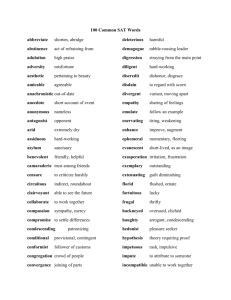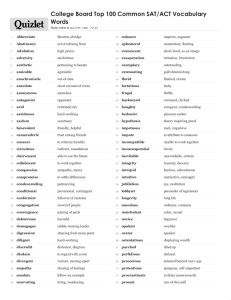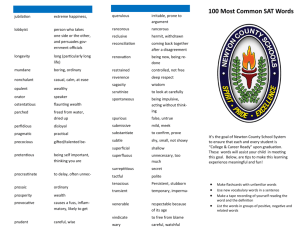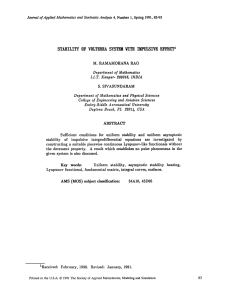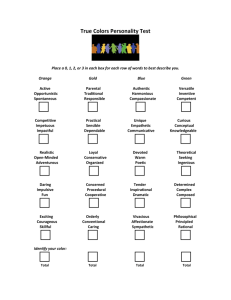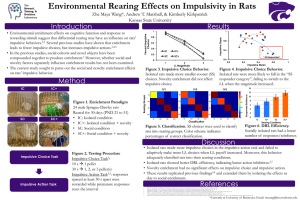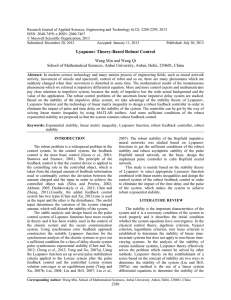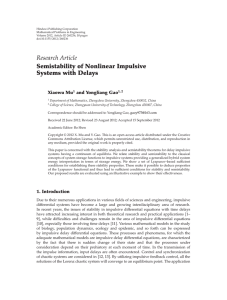CONTROLLABILITY IMPULSWE CONTR.OL SYSTEMS OPTIMAL OF
advertisement
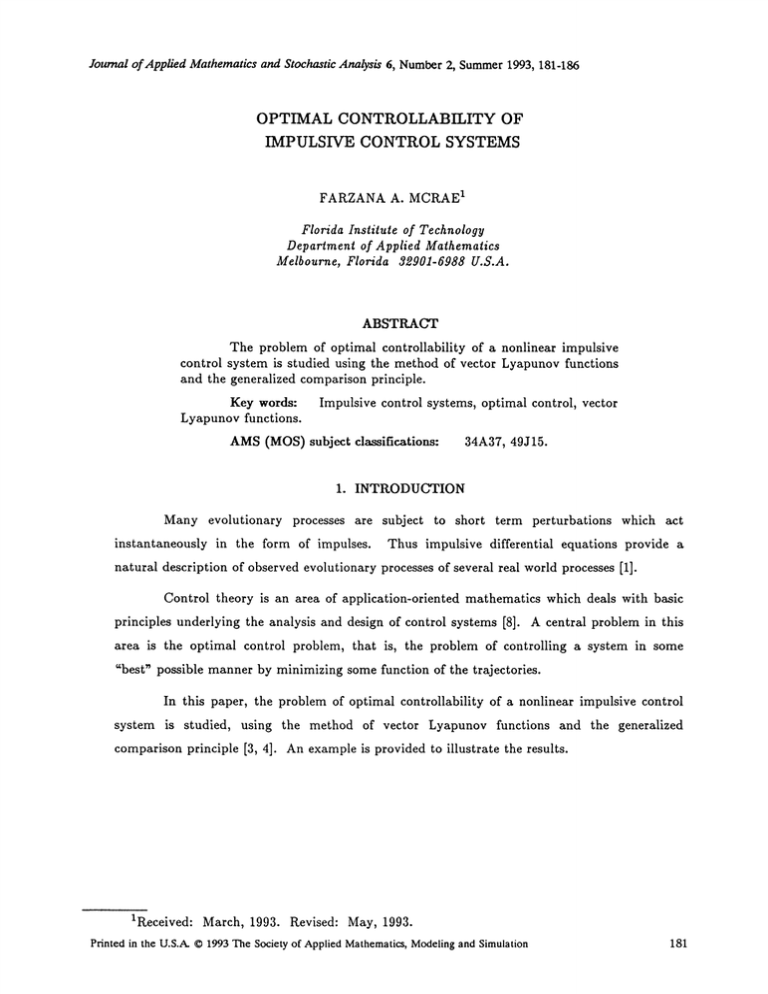
Journal of Applied Mathematics and Stochastic Analysis i, Number 2, Summer 1993, 181-186 OPTIMAL CONTROLLABILITY OF IMPULSWE CONTR.OL SYSTEMS FAtZANA A. MCRAE Florida Institute of Technology Depariment of Applied Mathematics Melbourne, Florida 32901-6988 U.S.A. ABSTICT The problem of optimal controllability of a nonlinear impulsive control system is studied using the method of vector Lyapunov functions and the generalized comparison principle. Key words: Impulsive control systems, optimal control, vector Lyapunov functions. AMS (MOS) subject classifications: 34A37, 49J15. 1. INTRODUCTION Many evolutionary processes are subject to short term perturbations which act instantaneously in the form of impulses. Thus impulsive differential equations provide a natural description of observed evolutionary processes of several real world processes [1]. Control theory is an area of application-oriented mathematics which deals with basic principles underlying the analysis and design of control systems [8]. A central problem in this area is the optimal control problem, that is, the problem of controlling a system in some "best" possible manner by minimizing some function of the trajectories. In this paper, the problem of optimal controllability of a nonlinear impulsive control system is studied, using the method of vector Lyapunov functions and the generalized comparison principle [3, 4]. An example is provided to illustrate the results. 1R.eceived: March, 1993. Revised: May, 1993. Printed in the U.S.A. (C) 1993 The Society of Applied Mathematics, Modeling and Simulation 181 FARZANA A. MCRAE 182 2. MAIN PSULTS We shall consider the following impulsive control system t#t, k=l,2,... =(to) < t 1 < t2... < t k <... and tkco I} C[RnxRm, gt n] for every k, k = 1,2,..., and where 0 as u = u(t) is a control vector. Let fl be the control prescribed. Corresponding to any control function u of (2.1) by z(t) = z(t; to, zo, u), with f E PC[R+ x Rnx Rm, Nn], k-.-,oo, = u(t), we shall denote a solution z(to) = z o. The following result deals with the optimal stabilization of (2.1). Assume that Theorem 2.1: (i) (ii) 0 <A<A are given, PC[+ xn,N+], V(t,z) is locally Lipschitzian in z, Q e [,+], x n x m, N], g(t, w, z, u) is quasimonolone nondecreasing in g PC[ + x N is nondecreasing for k = 1, 2,..., w and k: e syslem (2.1) admits (iii) C m is a convez, compact set aa for u(t) V , unique solutions for t + x S(A), ( !! = !1) _< Q(V(t,x)) <_ a( !1 = I ), a,b e %[R + ,R +] and (iv) (v) o and for (t,z) I = + z(=)II < p ow, I = I < A, p > A. B[V,t,z,u,g] Vt(t,z)+VT(t,z)f(t,z, uO)+g(t,V(t,z),z,u) < O, t Ck[V, tk, z,k] = AV + Ck(V(tk, z(tk)) = 0, k = 1,2,..., v(t ,=(t+ ))_ v(t,,=(t,)), (vi) B[V, t, z, u, g] >_ 0 for any u e fl, t 7 tk, (vii) a(A) < b(A) holds, (viii) any solution w(t, to, Wo) of w’ = where AV = g(t, w,z(t), u(t)), ao- ,((t,)) w(to) = wo >_ o ezists on t k, [to, cO and satisfies k = 1, 2,..., (2.2) Optimal Controllability of Impulsive Control Systems Q(wo) < a(A) implies Q(w(t, to, Wo) < b(A), t >_ to 183 (2.3) and lim w( t; to, Wo) = O. (2.4) Then, lhe control system (2.1) is practically asymptotically stable and the inequality g(s, V(s,z(s)),z(s), u(s))ds + E Ck(V(ti,,zz(tk )) k=l k--1 tO < V(to, o) holds. i.e. u E f assures optimal stabilization. Proof: (1) (2) Let u(t) ft. To prove this theorem, we have to show two things: the control u(t) f2 assures practical asymptotic stability, the relation (2.5) holds. z(t)=z(t;to, Zo, U) be the solution of (2.1) corresponding to the control Then, setting re(t) = V(t,z(t)), w o = V(to, Zo) and using assumptions (i)-(v), (vii) and (viii), we can prove that the system arguments of [1, 5, 7]. Then, we also have (2.1) is practically stable following the standard V(t,z(t)) < w(t;to, Wo) t > to. Consequently, (2.4) implies that lira :(t) = 0, which proves practical asymptotic stability. Now, to prove (2.5), let us suppose that another control u*(t) f2 also assures practical asymptotic stability of (2.1). Then, the corresponding solution :*(t) also satisfies 1[ :*(t)[[ < A, >_ to, provided [1 zo [1 < A, and limt...oo:*(t) = 0. This implies that tim and we also have from V(t,z*(t)) O (2.7) = o. (2.8) (2.6) Then, by (iv), we get g(s, V(s, zOz)),z(s), u(s))ds + But by (2.7) antc (vi), E Ck (V(tk’zO(tk)) <- V(to’Zo)" k=l we get (2.9) FARZANA A. MCRAE 184 >_ V(to,.o). + tO The inequalities (2.10) k=l (2.9) and (2.10) prove the desired relation (2.5) and the proof is complete. Q.E.D. The following simple example illustrates this result. Example 2.1: Consider the following impulsive control system = F(t,z)+ R(t,z)u z(t+ = bz k = 1,2,..., (2.11) =(to) = =o where F E PC[R+ x R", R"], R(t,z) is an n x m matrix and u is a control. We shall base the solution of the problem on the consideration of the function V(t,z) given by N V(t,z) = where E aiVi(t’z)’ ai = const > 0 Vi(t v) are the components of Lyapunov’s vector function. Suppose we have Vt(t,z + vTx(t,z)F(t,z) =_ p(t, z) _< A’(t)V(t,z) where (2.12) ,V(t) > O, t >_ to and I E CI[R + ,R + ]. Define, for t tk, B[V,t,z,u] = p(t,z) + vTzR(t,z)u + w(t,z) + uTDu (2.13) where D is an m x m non-singular matrix. We shall find the control u = u(t) E fl from the condition of the minimum of B: t,z, u] = 0 at u = u B/V, -[V, t,x, u] 0 at u = uO. 0 Thus we obtain RT(t,z)Vx(t,=) + 2Du and it then follows that 0 185 Optimal Controllability of impulsive Control Systems u(t) = -1/2D- xRT(t,x)V(t,x). To discuss the problem of minimization of (2.17) f0 g(s,V(s,z(s)),z(s)),u(s,z(s)))ds, we obtain from (2.13), (2.14) and (2.16) the relation uOT Duo w( t, v) q- p( t, z) =0 which yields w(t,z) = p(t,z) + uTDu. Thus TDuo uTDu <_ A’(t)V-uTBu uTDu, t t k. g(t, v, z, u) = p(t, z) For t = tk, we want u - V(t+,x(t < dtV(tl,z(tt)) < e (tk)- )(tk + 1) ,c > 1. stabilization of (2.1). where cd k Thus, u -1/2D-11T(t,x)Vx(t,x) (2.19) assures optimal REFERENCES [1] Bainov, D.D., Lakshmikantham, V., and Simeonov, P., Theory of Impulsive Differential Equations, World Scientific, Singapore 1989. [2] Barnett, S. and Cameron, R,.G., Introduction to Mathematical Control Theory, Oxford University Press, Oxford, England 1985. [3] Lakshmikantham, V. and Leela, S., Academic Press, New York 1969. [4] Lakshmikantham, V., Matrosov, V.M. and Sivasundaram, S., Vector Lyapunov Functions and Stability Analysis of Nonlinear Systems, Kluwer Academic Publishers, The Netherlands 1991. Differential and Integral Inequalflies, Vol. I, Lakshmikantham, V., Leela, S., and Martynyuk, A.A., Practical Stability of Nonlinear Systems, World Scientific, Singapore 1990. [6] Martynyuk, A.A., On practical stability and optimal stabilization of controlled motion, Math. Control Theory, Banach Center Publications 14, (1985), pp. 383-398. [7] McPae, F.A., Practical stability of impulsive control systems, JMAA, to appear. Sontag, E.D., Mathematical Control Theory, Springer-Verlag, Berlin 1990.

